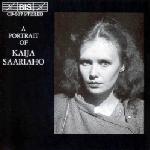[contextly_auto_sidebar id=”CRRqStIBmpYdmSguLgIo8y1dooOQBZsV”]
ONE of the several nice things about conductor Esa-Pekka Salonen being back more solidly in Los Angeles, where he has a post with the LA Phil, is the steady infusion of strong new or modern music from Scandinavia, a region which has been on a roll for the last few decades.
Last night I saw a Salonen-conducted concert at Walt Disney Concert Hall that includes pieces by Janacek, Sibelius and the conductor’s Finnish contemporary, Kaija Saariaho.
Her piece Earth Shadows (Maan varjot in Finnish), made its world premiere in Montreal in the spring. It has a second movement that is just as eerie and harmonically strange as Brian Eno’s ’70s music. The piece, which includes an organ, deserve s to be performed more widely. There’s a descending figure on the strings that made me feel like my seat was moving.
s to be performed more widely. There’s a descending figure on the strings that made me feel like my seat was moving.
Here’s Mark Swed’s review of the whole concert.

Sallinen and Rautavaara are the truly great Finnish composers in the post-Sibelius era. I know Saariaho’s opus quite well, and while she has some excellent compositions to her name, she seldom reaches the musical pinnacles of Sallinen and Rautavaara.
Do you mean Salonen, or is there another Finn with a similar name?
I mean Aulis Sallinen (b. 1935). His complete symphonies were released on the cpo label not too long ago. They are masterpieces one and all.
He is also known for his operas, however. Ratsumies (The Horseman, 1975) was the work that launched the great Finnish opera boom and, especially, Kuningas lähtee Ranskaan (The King Goes Forth to France, 1983). Both were premiered at the Savonlinna Festival and the latter was commissioned jointly by the Savonlinna Opera Festival, the Royal Opera House (Covent Garden) and the BBC.
The symphonic work Shadows, based on his opera The King Goes Forth to France, was composed for the National Symphony Orchestra and its conductor Mstislav Rostropovich
The National Symphony Orchestra, cond. by Mstislav Rostopovich premiered it in Washington D.C. on November 30, 1982.
Shadows was such a success that the National Symphony Orchestra Association immediately commissioned his Symphony No. 5, “Washington Mosaics” (1985). It, too, was premiered by the National Symphony Orchestra under Mstislav Rostropovich in Washington D.C. on October 10, 1985.
His Symphony No. 8 “Autumnal Fragments” (2001), was commissioned by the Concertgebouw Orchestra and premiered by the Concertgebouw Orchestra, cond. by Paavo Järvi in Amsterdam on April 16, 2004.
His Chamber Music VI – 3 invitations au voyage (2005-2006), for solo string quartet and string orchestra was commissioned by L’Association Musique Nouvelle en Liberté, Ville de Paris and Mécénat Musical Société General. It was first performed by Le Quatuor Debussy and the Orchestre d’Auvergne, cond. by Arie van Beek at the Festival Paris de la musique in Paris on October 5, 2006.
These are just some examples, as he has received commissions from New Zealand, the Gothenburg Symphony Orchestra, the Orchestre Philharmonique de Monte Carlo (Ouverture solennel was dedicated to H.S.H. Prince Rainier III on the occasion of the 700th Anniversary of the Grimaldi Dynasty in 1997), the English Chamber Orchestra, the Amsterdam Sinfonietta, the Württembergisches Kammerorchester Heilbron, the Scottish Ensemble and the Sydney Conservatory of Music, etc. etc. etc.
I am astounded if you’ve never heard of him. He is just about the most famous and widely performed composer from Scandinavia.
Well, just about the most famous and widely-performed living composer from Scandinavia (assuming that you count Finland as part of Scandinavia, which many people there do not).
By now, in North America, at least, I think Rautavaara has probably moved ahead of Sallinen in terms of widespread performances.
That’s entirely possible. However, Finland IS part of Scandinavia for reasons of historical connections with Sweden. If you asked General Mannerheim, he’d definitely say Finland was part of Scandinavia and not some vassal state of Russia like Cuba. Just because Finnish isn’t a Germanic language doesn’t exclude the country from the region, just as Hungarian and Romanian don’t exclude those countries from being part of Central Europe.
The only country that’s debatable as a part of Scandinavia is Iceland, but most Danes would say it wasn’t a part of Scandinavia after its unilateral secession in 1944, when Denmark was still occupied by Nazi Germany.
I tend to follow the general programming trends here in the US, and I wouldn’t say Rautavaara is performed more often than Sallinen – though perhaps the Minnesota Orchestra under Vanska may have performed Rautavaara more often than Sallinen. Regardless, both are underrepresented in US programming. Especially when compared to mediocre composers like Golijov, Gubaidulina and Jennifer Higdon.